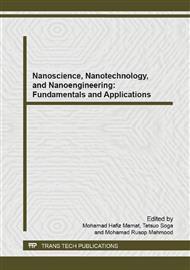p.365
p.370
p.376
p.381
p.385
p.390
p.395
p.401
p.405
High Yield Preparation of Graphene Oxide Film Using Improved Hummer’s Technique for Current-Voltage Characteristic
Abstract:
Nowadays, graphene (Gr) is one of the most promising materials in the field of nanoscience and nanotechnology and has attracted extensive attention in variety of applications, such as solar energy, environmental management, sensor, electronic device as well as energy storage and conversion. From a theoretical point of view, Gr provides the ultimate two-dimensional (2D) model of a catalytic support with sp2 hybridized carbon atoms. Its unique physical, chemical and mechanical properties are outstanding, and could allow the preparation of this composite material with unprecedented characteristics, such as superior electron mobility, good conductivity, excellent transparent property and high chemical stability. These unique characteristics inherent to well-defined 2D Gr are suitable for facilitating a wide range of transformations and may offer extraordinary potential in the design of novel catalytic systems. Herein, a simple and well-controllable Improved Hummer’s method was presented for the first time by controlling it’s stirring duration for high yield production of GO (62.50%). Based on our preliminary results, it was found that large amount of oxygen functional groups appeared after the conversions of graphite into graphene oxide (GO) by applying the vigorous stirring speed for 72 hours continuously. The main reason mainly attributed to the improvement of the mass transfer rate of oxygen molecules during the oxidation reactions; thus, high yield of GO could be achieved under this experimental condition. In addition, the resultants GO exhibited higher short-circuit currents with 290 μA compare to short circuit of Gr with 70 μA under light simulation condition.
Info:
Periodical:
Pages:
385-389
Citation:
Online since:
June 2015
Authors:
Keywords:
Price:
Сopyright:
© 2015 Trans Tech Publications Ltd. All Rights Reserved
Share:
Citation:


